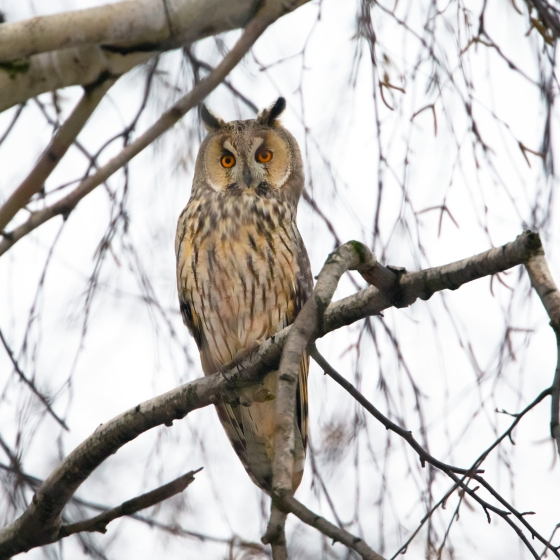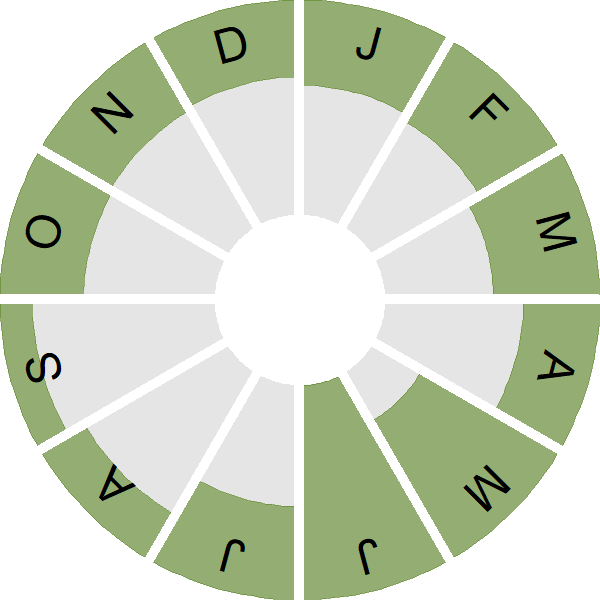Long-eared Owl

Introduction
The Long-eared Owl is perhaps our most secretive owl. Almost entirely nocturnal in its habits it is a very difficult bird to census.
Its bright orange eyes, long 'ear tufts' and chestnut plumage ensure that any sighting of a Long-eared Owl is a treasured one. A denizen of deep woodland and scrubby shelterbelts, the Long-eared Owl is more often heard than seen. The best time to assess numbers, or even the presence of Long-eared Owls, is during the summer months when the 'squeaky gate' call of the young can be heard.
During harsh winters on the Continent our resident birds may be joined by migrant Long-eared Owls escaping the cold conditions. At this time of the year individuals may congregate in communal winter roosts, though the numbers of winter immigrants has decreased over recent years.

Key Stats
Identification
ID Videos
This section features BTO training videos headlining this species, or featuring it as a potential confusion species.
Short-eared and Long-eared Owls
Songs and Calls
Song:
Song:
Call:
Begging call:
Status and Trends
Conservation Status
Population Change
The Long-eared Owl is a scarce species in the UK and is monitored by the RBBP; however as a nocturnal species which is difficult to detect it is substantially under-reported and the trend is uncertain (Eaton et al. 2021). The most recent UK population estimate is 1,800+ pairs (APEP4) but this is also highly uncertain. The number of occupied 10-km squares in Britain has declined by 18% since the 1968–72 Breeding Atlas, but the map shows many gains and losses which may suggest difficulties in detecting the species when present (Balmer et al. 2013).
Distribution
Long-eared Owls breed at scattered locations in Britain and throughout Ireland. In Ireland the Long-eared Owl is the most abundant owl species, and probably benefits from the absence of the competitively dominant Tawny Owl. Long-eared Owls are sedentary throughout Britain & Ireland but are joined by annually variable numbers of autumn immigrants from Fennoscandia. The winter distribution is patchy throughout both Britain and Ireland and likely to suffer from under-recording.
Occupied 10-km squares in UK
or view it on Bird Atlas Mapstore.
or view it on Bird Atlas Mapstore.
European Distribution Map
Distribution Change
The Long-eared Owl's breeding range has apparently contracted by 18% since the 1968–72 Breeding Atlas but there is also marked turnover, with more than half of squares showing gains or losses since 1968–72. This may be partly a consequence of birds being missed in one atlas or another, but the significant gains in northern England and clusters of losses in southeast England, southwest Scotland and the Black Isle are notable.
Change in occupied 10-km squares in the UK
or view it on Bird Atlas Mapstore.
or view it on Bird Atlas Mapstore.
Seasonality
Long-eared Owls are present throughout the year but not often recorded on daytime lists. Reporting is slightly higher in summer when juveniles are easily detected by their squeaky calls.
Weekly pattern of occurrence
The graph shows when the species is present in the UK, with taller bars indicating a higher likelihood of encountering the species in appropriate regions and habitats.

Movement
Britain & Ireland movement
Foreign locations of birds ringed or recovered in Britain & Ireland
Dots show the foreign destinations of birds ringed in Britain & Ireland, and the origins of birds ringed overseas that were subsequently recaptured, resighted or found dead in Britain & Ireland. Dot colours indicate the time of year that the species was present at the location.
- Winter (Nov-Feb)
- Spring (Mar-Apr)
- Summer (May-Jul)
- Autumn (Aug-Oct)

European movements
EuroBirdPortal uses birdwatcher's records, such as those logged in BirdTrack to map the flows of birds as they arrive and depart Europe. See maps for this species here.
The Eurasian-African Migration Atlas shows movements of individual birds ringed or recovered in Europe. See maps for this species here.
Biology
Productivity and Nesting
Nesting timing
Egg measurements
Clutch Size
Incubation
Survival and Longevity
Survival is shown as the proportion of birds surviving from one year to the next and is derived from bird ringing data. It can also be used to estimate how long birds typically live.
View number ringed each year in the Online Ringing Report.
lifespan
Survival of adults
Survival of juveniles
Biometrics
Wing length and body weights are from live birds (source).
Wing length
Body weight
Ring Size
Classification, names and codes
Classification and Codes
- Order: Strigiformes
- Family: Strigidae
- Scientific name: Asio otus
- Authority: Linnaeus, 1758
- BTO 2-letter code: LE
- BTO 5-letter code: LOEOW
- Euring code number: 7670
Alternate species names
- Catalan: mussol banyut
- Czech: kalous ušatý
- Danish: Skovhornugle
- Dutch: Ransuil
- Estonian: kõrvukräts
- Finnish: sarvipöllö
- French: Hibou moyen-duc
- Gaelic: Comhachag-adharcach
- German: Waldohreule
- Hungarian: erdei fülesbagoly
- Icelandic: Eyrugla
- Irish: Ceann Cait
- Italian: Gufo comune
- Latvian: ausaina puce
- Lithuanian: mažasis apuokas
- Norwegian: Hornugle
- Polish: uszatka (zwyczajna)
- Portuguese: bufo-pequeno
- Slovak: myšiarka ušatá
- Slovenian: mala uharica
- Spanish: Búho chico
- Swedish: hornuggla
- Welsh: Tylluan Gorniog
Research
Causes of Change and Solutions
Causes of change
Due to the difficulties in detecting the species the trend is uncertain and hence the drivers of change are also unclear.

